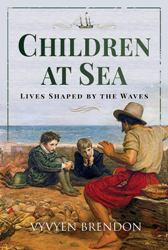 Pirates and Privateers Pirates and Privateers
The History of Maritime
Piracy
Cindy Vallar, Editor
& Reviewer
P.O. Box 425,
Keller, TX 76244-0425
    
Books for
Adults ~ Exploration, Trade, & Travel

Children at Sea: Lives Shaped
by the Waves
by Vyvyen Brendon
Pen & Sword, 2020, ISBN 978-1-52677-244-2 US $29.95
/ UK £21.65
Review by Irwin Bryan
    
This book
tells the stories of boys and girls who do something
surprisingly commonplace in the 18th and 19th
centuries. They board ships and cross oceans without
a parent or guardian present. Some are sent by
British parents, working for the East India Company,
back to England for a proper schooling. Other
children, whose parents are either dead or unable to
raise them, are sent to Canada’s boarding schools or
the youngest to foster families. During the wars
against France and America, many boys also ship out
as midshipmen at an early age. Most
of the subjects in this book do not leave a record
of their experiences. Some particulars of these
children’s voyages are provided through other
passengers who regularly write about their own journeys or
corresponded.
Our first young traveler is fourteen-year-old
Mary Branham. She has the distinction of being found
guilty of theft and is sent to Botany Bay with the
first fleet transporting convicts in 1787. Many people describe their
experiences along the way. The overcrowding,
sickening stench, coarse foods, and perception that
returning to England will be almost impossible all
serve to increase their sorrows.
Next is the story of Joseph Emidy, a young lad
captured in Africa and sent to Brazil. He is bought
by a man looking to add house slaves. These
individuals may have had better lives than field
slaves, but living in the owner’s home means they
also lack the camaraderie of other slaves and their
community. Incredibly, Joseph is musically talented
and becomes a skilled violinist. At a time when many
people cannot read and teaching slaves to read is
generally outlawed, Joseph learns to read books and
music. He is able to work as a musician and music
teacher outside of his master’s home and retains
some of the money he earns to eventually buy his
freedom. He crosses the Atlantic a second time when
he accompanies his master back to Portugal. Of
course, this voyage holds none of the fears he felt
as a captive on a slaver. In Lisbon, he becomes a
sought-after musician and performs around the city
and during church services.
For each child voyager the author claims their
journeys leave an impact that affects them in later
life. So, each child’s life after the voyage and
until they die is presented. If they have other
siblings, the lives each leads is compared to the
subject child.
In most cases, I saw other factors that had more
meaningful impacts on these young lives than the
hardships of the voyages. Mary Branham knew the
chances of returning to England were so slim that
she suffered from intense homesickness more than
anything else. Joseph’s life was happy and included
his freedom and an interesting career, a far cry
from the young African’s fears aboard the slaver.
Several boys went to sea as new midshipmen in the
navy. One was small and frail, which had the most
impact on his life; another was sullen and lacked
drive or ambition. Overall, these sailors’ lives
were not really impacted much by the voyages they
undertook. They had volunteered for naval service,
were taught sailing skills, as well as sword
fighting and cannon firing, and enjoyed the
alcohol-fueled antics of the midshipmen’s berth.
Most of these boys died from accidents, illness, or
war. Only two served long enough to be commissioned
as lieutenants; other survivors’ service ended when
wars ended.
One of the more interesting chapters describes the
naval life of Charles Dickens’s son, Sydney. This is
told through the correspondence of the writer and
sometimes compares Sydney’s life to the children
Dickens writes about in his novels.
The children sent from India to boarding schools and
the children of destitute mothers sent to live in
Canada experienced a sense of loss and separation.
The severed connection to family was the worst
memory of their journeys. I had no idea that (mostly
single) mothers could simply give up their children
or that the children who fostered with Canadian
families were really indentured servants required to
“work” when they got older. This practice continued
well in to the 20th century.
Children at Sea has many endnotes and
includes a detailed bibliography and index.
Black-&-white illustrations feature the people
and places mentioned in the text.
Anyone with an interest in family life during the
Georgian and Victorian eras will be happy they
choose this book. Others may enjoy learning about
the ways a child’s life in the past differs from
what is normal now. All the different voyages make
this a remarkably interesting sea story that will
entertain and enlighten all readers.
Review Copyright ©2021 Irwin Bryan

Click to contact me
Background image compliments
of Anke's Graphics |

